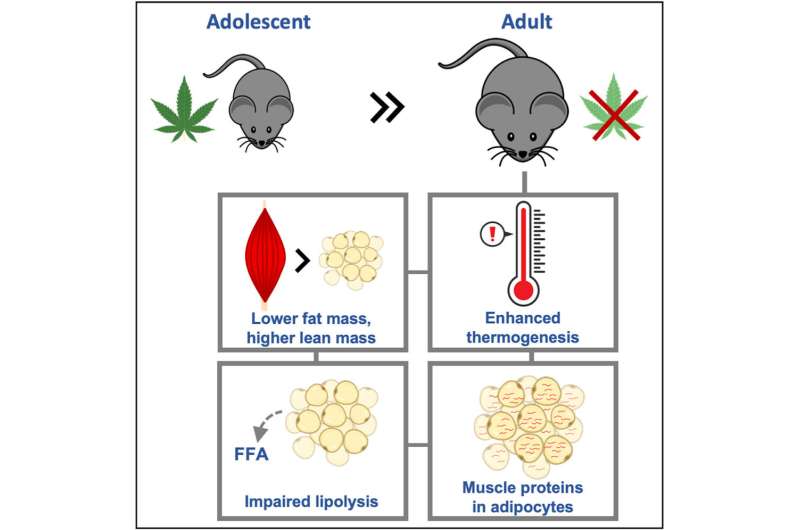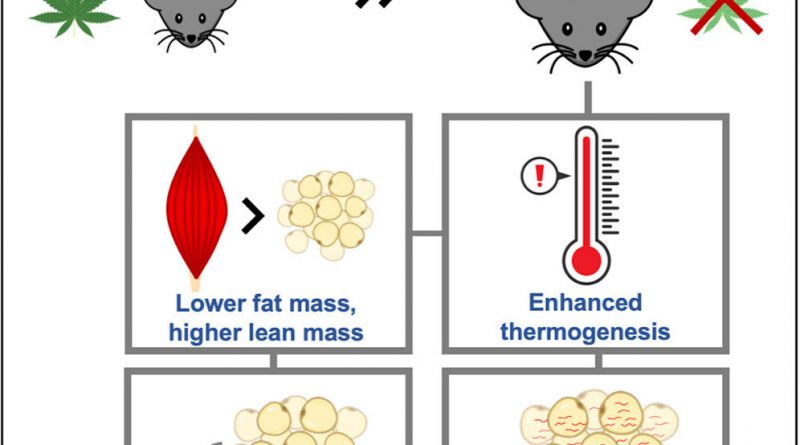New research may explain why, despite ‘the munchies,’ frequent cannabis users are leaner than non-users

Despite getting “the munchies,” people who frequently use cannabis are leaner and less prone to diabetes than those who don’t. University of California, Irvine researchers have now uncovered a possible explanation for this paradox—and it’s not good news. The findings are reported in a new study titled, “Adolescent exposure to low-dose THC disrupts energy balance and adipose organ homeostasis in adulthood,” published today in Cell Metabolism.
Many adults who consume cannabis daily or almost daily begin using the drug when they are teenagers. During this time of rapid physical development, the new study shows, cannabis can wreak havoc in the fine-tuned processes that govern energy storage, making the body leaner and less susceptible to obesity but also less capable of mobilizing stored nutrients needed for brain and muscle activity. These alterations are rooted in striking molecular changes that occur within the body’s fat depots, also known as the adipose organ, which—after exposure to cannabis—start making proteins that are normally found only in muscle and the heart.
Researchers gave low daily doses of THC or its vehicle to adolescent mice. They then stopped the treatment, and after the animals had reached adulthood, carried out a thorough assessment of the animals’ metabolism. The results were surprising. Mice that had been treated as adolescents with THC, but were now drug-free, had reduced fat mass and increased lean mass, were partially resistant to obesity and hyperglycemia, had higher-than-normal body temperature, and were unable to mobilize fuel from fat stores. Several of these features are also seen in people who frequently use cannabis.
To make sense of these data, the researchers dove into the molecular changes caused by THC. What they uncovered was even more surprising: fat cells of mice treated with THC looked normal under the microscope but produced large amounts of muscle proteins, which are normally not found in fat. Muscle, on the other hand, made fewer of those same proteins.
The researchers concluded that the effort required to make these “alien” proteins interferes with the healthy functioning of fat cells and thus with their ability to store and release stored nutrients. This may in turn affect not only physical activity but also mental processes, such as attention, which depend on a steady influx of fuel to the brain.
“All too often we think of cannabis only as a psychoactive drug,” said Daniele Piomelli, Ph.D., director for the UCI Center for the Study of Cannabis, the Louise Turner Arnold Chair in the Neurosciences, and professor in the UCI School of Medicine Department of Anatomy & Neurobiology, “But, its effects extend well beyond the brain. Its main constituent, THC, mimics a group of chemical messengers called endocannabinoids, which regulate important functions throughout the body. Our results show that interfering with endocannabinoid signaling during adolescence disrupts adipose organ function in a permanent way, with potentially far-reaching consequences on physical and mental health.”
More information:
Lin Lin et al, Adolescent exposure to low-dose THC disrupts energy balance and adipose organ homeostasis in adulthood, Cell Metabolism (2023). DOI: 10.1016/j.cmet.2023.05.002
Journal information:
Cell Metabolism
Source: Read Full Article



